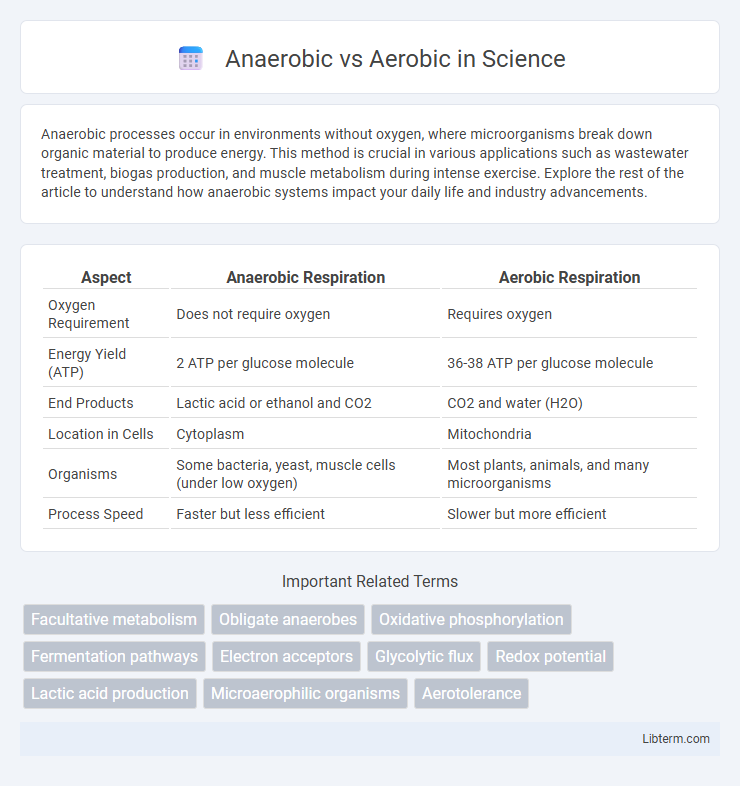Anaerobic processes occur in environments without oxygen, where microorganisms break down organic material to produce energy. This method is crucial in various applications such as wastewater treatment, biogas production, and muscle metabolism during intense exercise. Explore the rest of the article to understand how anaerobic systems impact your daily life and industry advancements.
Table of Comparison
| Aspect | Anaerobic Respiration | Aerobic Respiration |
|---|---|---|
| Oxygen Requirement | Does not require oxygen | Requires oxygen |
| Energy Yield (ATP) | 2 ATP per glucose molecule | 36-38 ATP per glucose molecule |
| End Products | Lactic acid or ethanol and CO2 | CO2 and water (H2O) |
| Location in Cells | Cytoplasm | Mitochondria |
| Organisms | Some bacteria, yeast, muscle cells (under low oxygen) | Most plants, animals, and many microorganisms |
| Process Speed | Faster but less efficient | Slower but more efficient |
Introduction to Anaerobic and Aerobic Processes
Anaerobic processes involve the breakdown of organic matter in the absence of oxygen, primarily through fermentation or anaerobic respiration, producing energy and by-products such as methane or lactic acid. Aerobic processes require oxygen to convert substrates into carbon dioxide, water, and energy, enabling more efficient ATP production in organisms. Both processes are fundamental in biological systems, influencing waste treatment, energy metabolism, and ecological nutrient cycles.
Defining Anaerobic and Aerobic Exercise
Anaerobic exercise involves high-intensity activities that rely on energy sources stored in the muscles without using oxygen, such as sprinting or weightlifting. Aerobic exercise requires sustained, moderate-intensity effort that depends on oxygen intake to fuel muscles, including activities like running, swimming, or cycling. Both exercise types improve fitness but target different energy systems and physiological adaptations.
Key Differences Between Anaerobic and Aerobic
Anaerobic respiration occurs without oxygen and produces energy quickly through glycolysis, resulting in byproducts like lactic acid or ethanol, while aerobic respiration requires oxygen and generates more ATP via the Krebs cycle and oxidative phosphorylation. Anaerobic processes are typically used for short bursts of intense activity, whereas aerobic respiration supports prolonged, endurance-based efforts. The efficiency difference is significant, with aerobic respiration yielding about 36-38 ATP molecules per glucose compared to only 2 ATP in anaerobic conditions.
Energy Production Mechanisms
Anaerobic energy production occurs without oxygen, primarily through glycolysis, producing ATP quickly but yielding lactic acid as a byproduct. Aerobic energy production relies on oxygen, utilizing the Krebs cycle and electron transport chain within mitochondria to efficiently generate a high volume of ATP. The anaerobic pathway supports short, intense bursts of activity, while the aerobic pathway sustains prolonged, moderate-intensity exercise.
Common Examples of Anaerobic Exercises
Anaerobic exercises, such as sprinting, weightlifting, and high-intensity interval training (HIIT), involve short bursts of intense activity that do not rely on oxygen for fuel. These exercises primarily use glycogen stored in muscles for energy, leading to rapid muscle fatigue but significant strength and power gains. Unlike aerobic exercises like running or cycling, anaerobic workouts improve muscle mass, strength, and overall metabolic rate.
Common Examples of Aerobic Exercises
Common examples of aerobic exercises include running, swimming, cycling, and brisk walking, all of which rely on oxygen to generate energy through sustained muscle activity. These activities enhance cardiovascular endurance and improve lung capacity by engaging large muscle groups in continuous motion. Aerobic exercises also contribute to weight management and overall metabolic health by increasing the body's oxygen consumption rate.
Health Benefits of Anaerobic Workouts
Anaerobic workouts, such as high-intensity interval training (HIIT) and strength training, boost muscle mass, increase metabolic rate, and improve bone density, contributing to long-term health benefits. These exercises enhance insulin sensitivity, reduce visceral fat, and support cardiovascular health by improving blood pressure and cholesterol levels. Regular anaerobic training also promotes functional strength and endurance, reducing the risk of chronic diseases like type 2 diabetes and osteoporosis.
Health Benefits of Aerobic Training
Aerobic training significantly improves cardiovascular health by enhancing heart and lung function, increasing oxygen delivery throughout the body, and reducing risk factors like hypertension and high cholesterol. Regular aerobic exercise boosts metabolic rate, aids in weight management, and supports mental health by reducing anxiety and depression symptoms. These health benefits contribute to increased longevity, improved immune function, and better overall physical endurance.
Choosing the Right Exercise for Your Goals
Anaerobic exercises, such as weightlifting and sprinting, primarily improve muscle strength and power by relying on short bursts of high-intensity effort without oxygen. Aerobic exercises, including running, cycling, and swimming, enhance cardiovascular endurance and promote fat burning through sustained, oxygen-dependent activity. Selecting the right exercise depends on your fitness goals: choose anaerobic training to build muscle mass and explosiveness, or focus on aerobic workouts to increase stamina and support heart health.
Combining Anaerobic and Aerobic for Optimal Fitness
Combining anaerobic and aerobic exercises maximizes fitness by enhancing both muscle strength and cardiovascular endurance. Anaerobic workouts like weightlifting and sprinting build fast-twitch muscle fibers and improve power, while aerobic activities such as running and cycling boost oxygen consumption and stamina. This integrated approach promotes fat loss, muscle growth, and overall metabolic efficiency, leading to optimal physical performance and health.
Anaerobic Infographic

 libterm.com
libterm.com